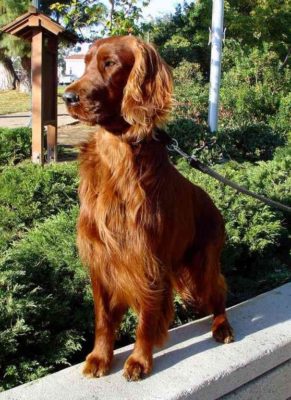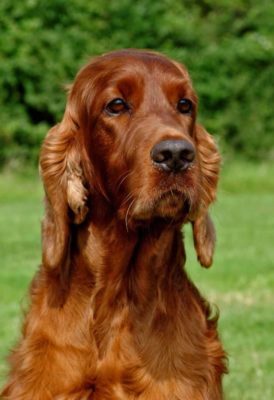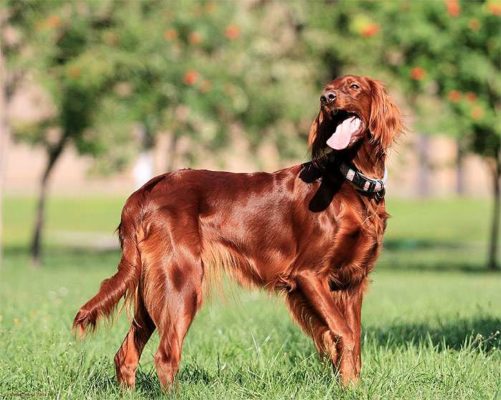Irish Setter

The Irish Setter’s temperament’s main feature is considered to be its attachment to its owner. It is a friendly, energetic, and intelligent dog who needs all family members’ care and affection. The Irish Setter is quite patient with children and does not mind playing active games. He is a real fidget and values every free minute of his master. He is quiet towards strangers but wary.
Table of Contents
Breed Information
| Another Name | Red Setter (Irish: sotar rua), Irish Red Setter |
| Origin | Ireland |
| Height | Males 58-67 cm Females 55-62 cm |
| Weight | 27-32 kg |
| Fur | Long |
| Color | Bright brown |
| Lifespan | 12-15 years |
| FCI Classification | Pointing Dogs |
| Group | Hunting dogs |
| Price | From $200 |
Breed Photos
Origin History
As an independent breed, the Irish Red Setter was formed in the 19th century. Until that time, red and white-red setters were considered one breed. The earliest mention of the breed dates back to the end of the 18th century. Letters have survived from breeder Maurice O’Connor, who spoke of buying land where he would “train his new red dogs.”
The Irish Setter was first introduced at a show in 1859. It is when the breed began to form and its popularization and spread throughout the world. Cynologists believe that the breeds used to breed the Irish Setter were the Bloodhound, the Setter Gordon, and the English Setter. At that time, only the aristocracy hunted waterfowl, so an assistant in such hunting was necessary. The Irish Setter was ideally suited to workhorse, thanks to its noble appearance and unsurpassed hunting instinct.
The first club of Irish Red Setter fans appeared in 1873. The breed was recognized by the Fédération Cynologique Internationale and got its official standard in 1954. Now the most popular Irish Setter is in its homeland and among hunters in the USA.
Appearance
Attractive appearance, luxurious appearance, and courage are the main features of the Irish Red Setter. It is a harmoniously built dog of a stretched format. It has an elongated build. Large in appearance and tall in feet. The head is long, tapering towards the nose, but looks compact. The eyes are close-set, almond-shaped, with an expressive and attentive gaze.
Thin and floppy ears – located at eye level and rounded toward the end. The neck is medium length, dry and strong. The chest is deep. The abdomen is taut. The limbs look lean but with well-developed musculature. The tail is located at the level of the back, saber-shaped, very mobile. The coat is straight and thick, nonuniform: behind the ears, on the chest, tail, and the back of the legs – the longest hair. Allowed colors: bright brown, deep copper, or gold-colored. Very rare and faint white spots on the muzzle, throat, chest, or toes are also possible.
Character
The Irish Setter’s temperament’s main feature is considered to be its attachment to its owner. It is a friendly, energetic, and intelligent dog who needs all family members’ care and affection. The Irish Setter is quite patient with children and does not mind playing active games. He is a real fidget and values every free minute of his master. He is quiet towards strangers but wary.
In addition to its excellent hunting instinct, it also has good guarding skills. In relationships with other animals can be a problem: Irish Red Setter is jealous and incredibly possessive. As for cats, early socialization is a must. Irish setters are used to “chase” them. And small animals, such as hamsters, can be mistaken for prey.
If you can provide your pet with long walks, he will feel comfortable in apartment life. Preferably, the Irish Setter should be kept in a large spacious house where it can run wild and expend all its energy.
Care
The Irish Red Setter requires regular grooming. It is especially true of his long, luxurious coat. It tends to tangle, so comb it out every two days. Pay attention to the condition of the dog’s ears as well. Clean the ears several times a week to prevent the accumulation of dirt and moisture. Frequent water procedures are not necessary; the Irish Setter can be bathed about four times a year. An active dog’s claws usually sharpen on its own. If this is not enough, trim them monthly.
Training
Training an Irish Red Setter requires a proper approach. A trusting relationship between pet and owner is important here. Most Irish Red Setter owners note his stubbornness and independence when following commands. Remember that Irish Red Setter training and education should begin as early as possible. This way, your pet will get used to you and know who the leader is. Be patient, as you will have to repeat what you have learned more than once. As long as the Irish Setter trusts you and can repeat the command perfectly. Take a gentle and persistent approach without aggression, so you don’t get an unruly dog.
Common Diseases
Unlike other leopard dogs, the Irish Setter is at risk for hereditary diseases:
- epilepsy;
- entropion;
- blindness (may result from a recessive gene);
- malignant tumors (melanomas);
- spinal cord pathology;
- congenital dilation of the esophagus;
- allergic dermatitis;
- intestinal congestion;
- hip dysplasia.
Nutrition
Feeding the Irish Setter should be regular and balanced. Breeders recommend feeding Irish Red Setters natural food, where lean meat should predominate. You can also use ready-made premium dry food. It will contain all the necessary micronutrients and vitamins for the pet.
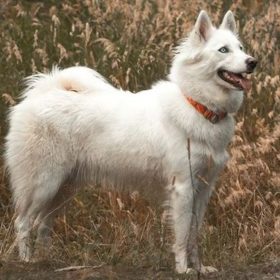 Yakutian Laika
Yakutian Laika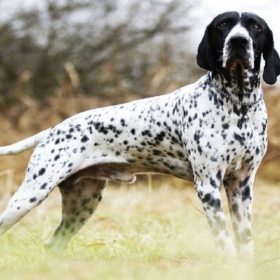 Braque d’Auvergne
Braque d’Auvergne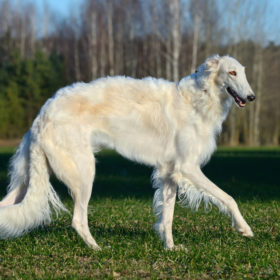 Borzoi
Borzoi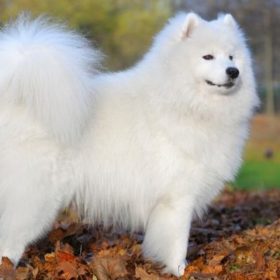 Samoyed
Samoyed Gończy Polski
Gończy Polski Neapolitan Mastiff
Neapolitan Mastiff